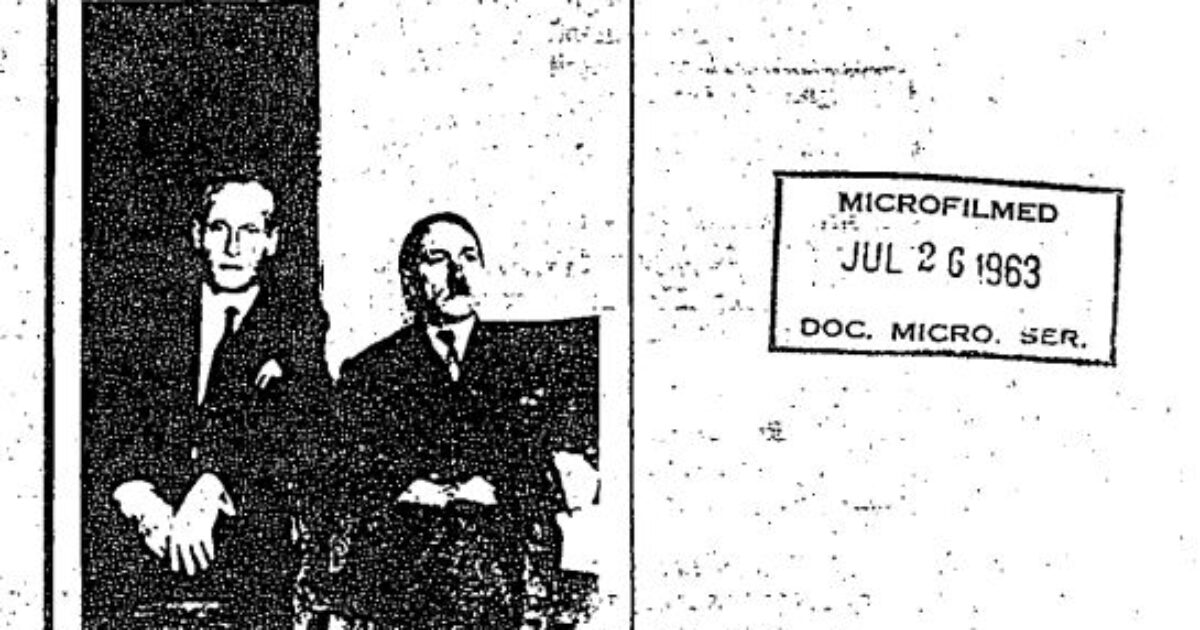Alleged photo of Adolf Hitler in Colombia following WWII.
A previously released classified document from 1954 is making the rounds again on the internet after its release years ago. The document claims Adolf Hitler survived World War II and was living in South America.
The document was the CIA’s response to the allegations that Hitler was living in Colombia and had been for several years.
Here is the full document Analysis of Document HVCA 2592 Suggesting Hitler Survived World War II.
In this document, the CIA responds to this explosive claim: The Acting Chief of the Station, Caracas, released a document where he alleges that a trusted friend delivered information that a former SS trooper stated to him casually that Adolf Hitler was still alive and living in Colombia.
The CIA document goes over the details of the claim that Hitler was still alive. Allegedly, an SS Officer traveled from Caracas to Colombia to see Hitler once per month.
The CIA later shot down these claims as Russian disinformation.
1. Executive Summary
This report analyzes a declassified CIA routing memo HVCA 2592 from October 1955 concerning a field intelligence claim that Adolf Hitler survived World War II, lived in Colombia and later Argentina, and remained alive as late as 1955. The document centers around a photographic “sighting” and the testimony of a former German SS officer allegedly named CITROEN.
While sensational in nature, the CIA explicitly characterized the report as unverified and “fantastic,” forwarding it without any endorsement or conclusion. No evidence
supporting the claim was validated. Nevertheless, internal routing shows the report was taken seriously enough to be circulated widely across Latin American field stations.
2. Document Summary
Key Details:
• Date: 3 October 1955
• Source: CIA station memo based on field intelligence from CIMELODY-3, who
reported that a former German SS officer (CITROEN) claimed Adolf Hitler was
alive in Colombia and had moved to Argentina in early 1955.
• Evidence Cited: A surreptitiously obtained photograph labeled ‘Adolf Hitler,
Mayor, Tunga, Colombia, 1954.’
• CIA’s Assessment: No validation was offered; the report was simply passed along
as ‘of possible interest.’
3. Analytical Context
1. Credibility Issues:
• The report is built entirely on second and third-hand hearsay.
• The CIA agent on record acknowledged they were ‘not in a position to
evaluate’ the claim and characterized it as ‘fantastic.’
• No technical analysis, corroborative testimony, or further investigative leads
were documented—just a circulated photo and a colorful anecdote.
2. Historical Intelligence Culture:
• In the postwar years, particularly during the early Cold War, U.S. intelligence
was saturated with leads on fugitive Nazis. Many of these were credible—like
Eichmann’s confirmed escape to Argentina—but others were wild and
unsubstantiated.
• This period saw an epidemic of disinformation, especially from émigré
networks, opportunists, and hostile intelligence services looking to sow
confusion.
4. Likely a Soviet Active Measure
This case bears the classic fingerprints of a KGB active measure—a This case bears the classic fingerprints of a KGB active measure—a type of strategic deception operation designed not to win with facts but to confuse, distract, and exhaust.
• Tactic: Sow a rumor just credible enough to force CIA stations to divert time, funds, and personnel to investigate it.
• Strategic Goal: Erode confidence in CIA intelligence-gathering processes, clutter internal communication channels, and bog down field offices with phantom targets.
• Why Hitler? Few narratives are more captivating or disruptive than the idea that the most hunted man in modern history managed to escape justice. By keeping that ember alive, Soviet disinformation could play both on American guilt (for potentially missing him) and pride (in hoping to be the ones to find him).
• Dissemination: By pushing the rumor through Latin American intermediaries, émigré Germans, and vaguely defined SS veterans, the Soviets could exploit postwar Nazi migration trails—many of which were real, thus giving the rumor a patina of plausibility.
This technique mirrors other known Soviet operations like:
• The Operation INFEKTION campaign falsely suggested the U.S. created AIDS.
• Forgeries placing Nazi war criminals in American employment to strain U.S.-European relations.
• Psychological operations targeted at West German and Latin American press, using forged documents and whispered rumors.
5. Conclusion
Rather than a revelation, this document should be read as an artifact of Cold War strategic psychological warfare. It represents not evidence of Hitler’s survival but evidence of how effectively rumor and myth were weaponized—turning intelligence agencies into unwitting actors in the geopolitical theater. The truth wasn’t the target. The hunt itself was the point.
Far from providing credible proof that Hitler escaped justice, this case exemplifies a Cold War-era disinformation trap. The document bears strong hallmarks of a Soviet active measure, likely intended to confuse, distract, and drain U.S. intelligence assets.
The extensive internal processing of this dubious report—by over a dozen personnel—illustrates just how effective the Soviet deception campaign was. By activating latent fears and historical anxieties, the Soviets successfully caused the CIA to chase shadows.
In short, the report stands not as evidence of Hitler’s survival but as evidence of Soviet success in weaponizing myth and rumor to manipulate U.S. intelligence during a critical period of the Cold War.
The post CIA Analysis of HVCA 2592 Suggesting Hitler Survived World War II and Lived in Colombia appeared first on The Gateway Pundit.











